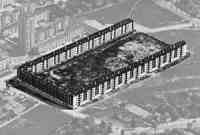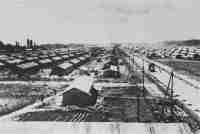 |
| Drancy Aerial View * |
The assembly camp (
Sammellager) at Drancy, a north-eastern suburb of
Paris, was established in
August 1941.
The camp was situated in a public housing project built
between 1932 and 1936 and
considered one of the most interesting and technically advanced developments of its kind to be erected during the
20th Century.
Known as "La Cité de la Muette", it was occupied for a short while as housing prior to WW2, before becoming
a gendarmerie barracks and then an assembly camp for the deportation of Jews. After the war, the buildings were
used for a time as an army barracks before being largely destroyed in
1976. Only the
large courtyard block that served as the assembly camp remains of the original development.
 |
| Drancy Courtyard * |
The camp measured 200x400 m, with a lookout tower at each corner, and was initially guarded by French gendarmes.
The capacity of the camp was 4,500 prisoners.
Between 21 August 1941 and
17 August 1944 70,000 prisoners passed through it.
At first the camp was administered by French personnel, but on
2 July 1943,
Alois Brunner assumed command, assisted by 4 SS-officers. All French police
were dismissed. In their place, prisoners served as members of an internal police service
("Membres du Service d’Ordre").
The conditions in the camp had been bad from inception, with the shortage of food a constant problem. The daily
ration measured 600-800 calories until
November 1942 but temporarily improved
at that time when prisoners were allowed to receive food parcels from their families and from French Jewish
organisations and the Red Cross. Under
Brunner’s control, conditions
rapidly deteriorated to their former state.
 |
| Gurs Deportation Camp *
|
The camp at Gurs, in the southwest of France, had been established as early as
April 1939
to hold Spanish republican soldiers fleeing in the wake of Franco’s victory. In
1940, 7,500 German Jews from Baden and the Saarpfalz were interned at Gurs in
appalling conditions. They lived in overcrowded barracks, slept on the ground and suffered from hunger and
cold in a damp, muddy region. During the
winter of 1940-41 alone, 800 prisoners died.
Gurs was only one of a number of camps established by the Vichy Government. Together, they held 20,000 Jewish
prisoners. When the deportations began, the trains from these camps were routed to Drancy, where Jews held in
camps in the occupied zone of France, such as
Pithiviers and
Beaune-la-Rolande, were added to the transports, together with those interned
at Drancy itself.
More than 3,000 Jews died in France during the period of occupation, 2,500 of them in the various camps in the
occupied zone and Vichy. Over 1,000 are buried in the cemetery at Gurs.
Of the 76,000 Jews deported from France, fewer than 3,000 survived.
Photos:
GFH
*
Gurs Website *
Sources:
1) Hilberg, Raul.
The Destruction of the European Jews. Yale University Press, New Haven 2003
2) Gutman, Israel ed.
Encyclopedia of the Holocaust. Macmillan Publishing Company, New York, 1990
© ARC 2005











